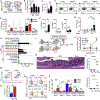The Intermucosal Connection between the Mouth and Gut in Commensal Pathobiont-Driven Colitis
- PMID: 32758418
- PMCID: PMC7414097
- DOI: 10.1016/j.cell.2020.05.048
The Intermucosal Connection between the Mouth and Gut in Commensal Pathobiont-Driven Colitis
Abstract
The precise mechanism by which oral infection contributes to the pathogenesis of extra-oral diseases remains unclear. Here, we report that periodontal inflammation exacerbates gut inflammation in vivo. Periodontitis leads to expansion of oral pathobionts, including Klebsiella and Enterobacter species, in the oral cavity. Amassed oral pathobionts are ingested and translocate to the gut, where they activate the inflammasome in colonic mononuclear phagocytes, triggering inflammation. In parallel, periodontitis results in generation of oral pathobiont-reactive Th17 cells in the oral cavity. Oral pathobiont-reactive Th17 cells are imprinted with gut tropism and migrate to the inflamed gut. When in the gut, Th17 cells of oral origin can be activated by translocated oral pathobionts and cause development of colitis, but they are not activated by gut-resident microbes. Thus, oral inflammation, such as periodontitis, exacerbates gut inflammation by supplying the gut with both colitogenic pathobionts and pathogenic T cells.
Keywords: Klebsiella; TH17; colitis; dysbiosis; inflammasome; inflammatory bowel disease; microbiota; oral bacteria; pathobiont; periodontitis.
Copyright © 2020 Elsevier Inc. All rights reserved.
Conflict of interest statement
Declaration of Interests The authors declare no competing interests.
Figures







Comment in
-
The oral-gut axis in IBD.Nat Rev Gastroenterol Hepatol. 2020 Sep;17(9):532. doi: 10.1038/s41575-020-0346-0. Nat Rev Gastroenterol Hepatol. 2020. PMID: 32636501 No abstract available.
-
Healthy mouth, healthy gut: a dysbiotic oral microbiome exacerbates colitis.Mucosal Immunol. 2020 Nov;13(6):852-854. doi: 10.1038/s41385-020-00341-y. Epub 2020 Aug 25. Mucosal Immunol. 2020. PMID: 32843674 No abstract available.
References
-
- Adachi O, Kawai T, Takeda K, Matsumoto M, Tsutsui H, Sakagami M, Nakanishi K, and Akira S (1998). Targeted disruption of the MyD88 gene results in loss of IL-1- and IL-18-mediated function. Immunity 9, 143–150. - PubMed
-
- Arfi A, Richard M, Gandolphe C, Bonnefont-Rousselot D, Thérond P, and Scherman D (2011). Neuroinflammatory and oxidative stress phenomena in MPS IIIA mouse model: the positive effect of long-term aspirin treatment. Mol. Genet. Metab 103, 18–25. - PubMed
Publication types
MeSH terms
Substances
Grants and funding
LinkOut - more resources
Full Text Sources
Other Literature Sources
Molecular Biology Databases

